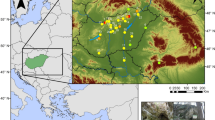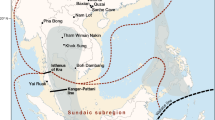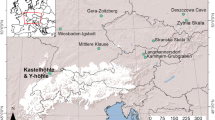Abstract
Drastic ecological restructuring, species redistribution and extinctions mark the Pleistocene–Holocene transition, but an insufficiency of numbers of well-dated large mammal fossils from this transition have impeded progress in understanding the various causative links1. Here I add many new radiocarbon dates to those already published on late Pleistocene fossils from Alaska and the Yukon Territory (AK–YT) and show previously unrecognized patterns. Species that survived the Pleistocene, for example, bison (Bison priscus, which evolved into Bison bison), wapiti (Cervus canadensis) and, to a smaller degree, moose (Alces alces), began to increase in numbers and continued to do so before and during human colonization and before the regional extinction of horse (Equus ferus) and mammoth (Mammuthus primigenius). These patterns allow us to reject, at least in AK–YT, some hypotheses of late Pleistocene extinction: ‘Blitzkrieg’ version of simultaneous human overkill2, ‘keystone’ removal3, and ‘palaeo-disease’4. Hypotheses of a subtler human impact and/or ecological replacement or displacement are more consistent with the data. The new patterns of dates indicate a radical ecological sorting during a uniquely forage-rich transitional period, affecting all large mammals, including humans.
This is a preview of subscription content, access via your institution
Access options
Subscribe to this journal
Receive 51 print issues and online access
$199.00 per year
only $3.90 per issue
Buy this article
- Purchase on Springer Link
- Instant access to full article PDF
Prices may be subject to local taxes which are calculated during checkout


Similar content being viewed by others
References
Grayson, D. K. & Meltzer, D. J. A requiem for North American overkill. J. Archaeol. Sci. 30, 585–593 (2003)
Martin, P. S. in Quaternary Extinctions (eds Martin, P. S. & Klein, R. G.) 345–403 (Univ. of Arizona Press, Tucson, 1984)
Zimov, S. A. et al. Steppe–tundra transition: a herbivore-driven biome shift at the end of the Pleistocene. Am. Nat. 146, 765–794 (1995)
MacPhee, R. D. E. et al. Radiocarbon chronologies and extinction dynamics of the Late Quaternary mammalian megafauna of the Taimyr Peninsula, Russian Federation. J. Archeaol. Sci. 29, 1017–1042 (2002)
Guthrie, R. D. Frozen Fauna of the Mammoth Steppe (Univ. of Chicago Press, Chicago, 1990)
Stephenson, R. O., Gerlach, S. C., Guthrie, R. D. & Mills, R. in Wildlife and People in Northern North America. Essays in Honor of R. Dale Guthrie (eds Gerlach, S. C. & Murray, M. S.) 125–159 (Br. Archaeol. Rep. Int. Ser., London, 2001)
Shapiro, B. et al. Rise and fall of Beringian steppe bison. Science 306, 1561–1565 (2004)
Potter, B. Site Structure and Organization in Central Alaska: Archaeological Investigations at Gerstle River Thesis, Univ. Alaska, Fairbanks (2004)
Bigelow, N. H. & Powers, W. R. Climate, vegetation, and archaeology 14,000–9,000 cal yr B.P. in Central Alaska. Arctic Anthropol. 38, 171–195 (2001)
Ager, T. A. in Late Quaternary Environments of the United States Vol. 2 (ed. Wright, H. E. Jr) 128–141 (Univ. Minnesota Press, Minneapolis, 1983)
Anderson, P. M., Bartlein, P. J., Brubaker, L. B., Gajewski, K. & Ritchie, J. C. Vegetation–pollen–climate relationships for arcto-boreal region of North America and Greenland. J. Biogeogr. 18, 565–582 (1991)
Guthrie, R. D. Rapid size decline in Alaskan Pleistocene horse before extinction. Nature 426, 169–171 (2003)
Bever, M. R. & Kunz, M. L. (eds) Between two worlds: Late Pleistocene cultural and technological diversity in eastern Beringia. Arctic Anthropology Vol. 38 (Univ. of Wisconsin Press, Madison, 2001)
Yesner, D. R. Human dispersal into interior Alaska: antecedent conditions, mode of colonization, and adaptations. Quat. Sci. Rev. 20, 315–327 (2001)
Powers, W. R. W., Guthrie, R. D. & Hoffecker, J. F. Dry Creek: Archaeology and Paleoecology of a Late Pleistocene Alaskan Hunting Camp (Dry Creek Rep. to the Natl Park Serv., Fairbanks, Alaska, 1983)
Goetcheus, V. G. & Birks, H. H. Full-glacial upland tundra vegetation preserved under tephra in Beringia National Park, Seward Peninsula, Alaska. Quat. Sci. Rev. 20, 135–147 (2001)
Franzmann, A. W. & Swartz, C. C. Ecology and Management of the North American Moose (Smithsonian Inst. Press, Washington DC, 2002)
Sher, A., Kuzmina, S. A., Kuznetsova, T. V. & Sulerzhitsky, L. D. New insights into the Weichselian Environment and climate of the east Siberian Arctic, derived from fossil insects, plants, and mammals. Quat. Sci. Rev. 24, 533–569 (2005)
Boeskorov, G. G. in Univ. of Alaska AQC Workshop Publ. 3rd Int. Mammoth Pre-Conference 8 (Alaska Quaternary Center Press, Fairbanks, 2003)
Hopkins, D. M., Smith, P. A. & Matthews, J. V. Jr. Dated wood from Alaska and the Yukon—implications for forest refugia in Beringia. Quat. Res. 15, 217–249 (1981)
Porter, S. C., Pierce, K. L. & Hamilton, T. D. in Late Quaternary Environments of the United States Vol. 1 (ed. Wright, H. E. Jr) 71–114 (Univ. Minnesota Press, Minneapolis, 1983)
Lozhkin, A. V. et al. Late Quaternary lacustrine pollen records from southwestern Beringia. Quat. Res. 39, 314–324 (1993)
Bryant, J. P. & Kuropat, P. J. Selection of winter forage by subarctic browsing vertebrates: the role of plant chemistry. Annu. Rev. Ecol. Syst. 11, 261–285 (1980)
Barnosky, A. D. et al. Assessing the causes of late Pleistocene extinctions on the continents. Science 306, 70–75 (2004)
Graham, R. W. & Lundelius, E. L. Jr. in Quaternary Extinctions (eds Martin, P. S. & Klein, R. G.) 223–250 (Univ. of Arizona Press, Tucson, 1984)
Kutzbach, J. E. & Street-Perrot, F. A. Milankovitch forcing of fluctuations in the level of tropical lakes from 18 to 0 kyr BP. Nature 317, 130–134 (1985)
Slobodkin, S. Western Beringia at the end of the Ice Age. Arctic Anthropol. 38, 31–47 (2001)
Dumond, E. E. & Bland, R. L. Holocene prehistory of the northernmost North Pacific. J. World Prehist. 9, 401–451 (1995)
Weinstock, J. et al. Evolution, systematics, and phylogeography of Pleistocene horses in the New World. PLoS Biol. 3, e241 (2005)
Matheus, P. M. Chronology and Ecology of a Late Quaternary Large Mammal Assemblage from Northern Alaska (US Dept Interior Rep. LBP 0119, Bur. Land Mgmt Northern Field Office, Fairbanks, Alaska, 2001)
Acknowledgements
I thank curators R. Tedford, R. Gangfloff, R. Harington and R. Purdy for dating access to museum collections, and M. L. Guthrie, F. Dean and D. Murray for suggestions that improved the manuscript. I also thank the NSF and the Tucson AMS laboratory.
Author information
Authors and Affiliations
Corresponding author
Ethics declarations
Competing interests
Reprints and permissions information is available at npg.nature.com/reprintsandpermissions. The author declares no competing financial interests.
Supplementary information
Supplementary Notes 1
The first section of the Supplementary Information summarizes information about the radiocarbon dates used in this study, their collection, and possible taphonomic problems pertaining to their collection. This is a necessary background to understanding the dates which are listed in the second section of the Supplementary Information. (DOC 31 kb)
Supplementary Notes 2
The second section is a list of radiocarbon dates plus their specimen identification, location, provenance etc., for both the new dates referred to in this study and the data set of relevant older published dates. (XLS 106 kb)
Rights and permissions
About this article
Cite this article
Dale Guthrie, R. New carbon dates link climatic change with human colonization and Pleistocene extinctions. Nature 441, 207–209 (2006). https://doi.org/10.1038/nature04604
Received:
Accepted:
Issue Date:
DOI: https://doi.org/10.1038/nature04604
This article is cited by
-
Reframing Prehistoric Human-Proboscidean Interactions: on the Use and Implications of Ethnohistoric Records for Understanding the Productivity of Hunting Megaherbivores
Journal of Archaeological Method and Theory (2023)
-
Collapse of the mammoth-steppe in central Yukon as revealed by ancient environmental DNA
Nature Communications (2021)
-
A Study of Fractured Proboscidean Bones in Recent and Fossil Assemblages
Journal of Archaeological Method and Theory (2021)
-
The timing and effect of the earliest human arrivals in North America
Nature (2020)
-
Moose genomes reveal past glacial demography and the origin of modern lineages
BMC Genomics (2020)
Comments
By submitting a comment you agree to abide by our Terms and Community Guidelines. If you find something abusive or that does not comply with our terms or guidelines please flag it as inappropriate.



